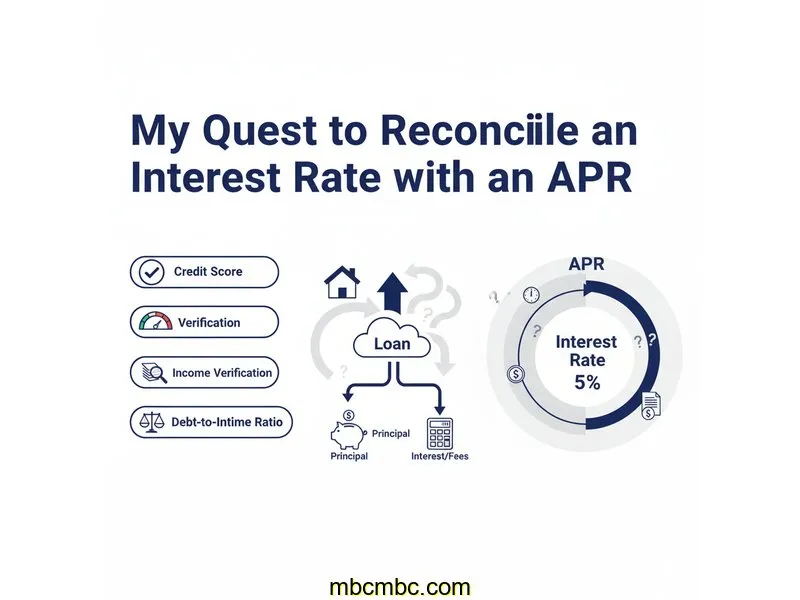
Auto Loan Calculator
Calculate payments over the life of your Loan
Home Blog Privacy Terms About Contact
Calculate payments over the life of your Loan
Home Blog Privacy Terms About ContactPublished on October 15, 2025

It all started on a quiet Tuesday afternoon. I was looking at some sample loan documents online, trying to build my own understanding of how they work. My eyes landed on two numbers that sat uncomfortably close to each other. One, in a large, friendly font, declared a "6.8% Interest Rate." Right below it, in a smaller, more serious typeface, was "7.2% APR."
They weren't the same. My immediate thought was, how can one loan have two different rates? Aren't they describing the same thing? It felt like looking at a ruler where an inch was somehow a different length depending on where you measured. A simple discrepancy sparked a genuine and intense curiosity. I wasn't trying to secure a loan; I was trying to secure an understanding.
My goal became singular: I had to figure out what APR really meant and why it was different from the interest rate. This wasn't about finding a "good deal" or making a financial choice. It was about solving a math puzzle that, for some reason, felt incredibly important. What was this second percentage telling me that the first one wasn't?
My first move was to fire up a standard loan calculator. I plugged in the numbers from the sample document: a principal of $11,750 and a term of 48 months. I typed in the 6.8% interest rate, hit "calculate," and got a monthly payment. But when I compared my result to the payment listed on the document, they didn't match. My number was a few dollars lower. I did it again, thinking I'd made a typo. The result was the same. A quiet sense of frustration began to build. This journey is simply a log of my process. Please remember, this is about understanding how calculations work, not financial advice.
The disconnect was small, but it was persistent. My simple calculation for an $11,750 loan over 48 months at a 6.8% rate consistently gave me a monthly payment of $279.08. The sample document, however, clearly stated the payment was $282.47. A difference of $3.39 per month might not sound like much, but over the life of the loan, it added up to more than $162. More importantly, the discrepancy meant my understanding was fundamentally flawed.
My first assumption was user error. I checked my math for converting the annual rate to a monthly one (dividing by 12), and it was correct. I tried a different online calculator, thinking the first one might be buggy. I got the exact same result: $279.08. The problem wasn't the tool; it was my process. I was missing a piece of the equation.
This is where the real frustration set in. I felt like I was speaking a different language than the loan document. I was using the big, bold numbers provided, but the conversation wasn't working. The monthly payment was the answer, but I clearly didn't have all the variables to get there. It was like trying to solve for 'x' without knowing the value of 'y'. The interest rate, the loan amount, and the term were all accounted for. What else could there possibly be?
Determined, I went back to the sample document and read every single line, not just the big print. Tucked away in a fee disclosure box, I found it: a "$235 Origination Fee." I had completely ignored it, assuming it was a separate charge paid at the beginning and unrelated to the monthly payment calculation. This little number was the key. My investigation shifted from blaming the calculator to finding a calculator that could speak the same language as the document—a tool that understood fees.
My breakthrough came when I searched for an "advanced loan calculator" or a "loan calculator with fees." I found one that had extra input fields beyond the basic principal, rate, and term. One of those fields was labeled "Origination Fees." This felt like finding a secret door.
With a sense of anticipation, I entered all the known variables again: $11,750 for the loan amount, 6.8% for the interest rate, and 48 for the term in months. Then, I navigated to the new field and carefully typed in the $235 origination fee. I held my breath and clicked the calculate button.
The screen refreshed, and two numbers appeared that made everything snap into focus. The monthly payment was now $282.47. And right next to it, the calculated APR was 7.20%. It matched. It all matched perfectly. The feeling wasn't just relief; it was a genuine "aha!" moment. The APR wasn't a second, mysterious interest rate. It was the total annualized cost of the loan, expressed as a percentage. It was the interest rate plus the amortized cost of the fees, all bundled into one standardized number.
My journey didn't stop there. I needed to internalize this concept. The APR isn't just a number; it's a translation. It translates the upfront expense of fees into an equivalent annual rate, allowing for a more transparent comparison between different loan offers. A loan with a very low interest rate but high fees might have a higher APR than a loan with a moderate interest rate and no fees.
I realized that the whole point of disclosing the APR is "truth in lending." It's a legally required metric designed to prevent confusion. It creates a level playing field. Instead of having to manually calculate the long-term expense of fees for every offer, the APR does it for you. It answers the question, "Taking everything into account, what is the yearly percentage cost of this loan?"
To be sure this wasn't a fluke, I created a new hypothetical scenario. I imagined a loan for $18,300 over 60 months with a 5.9% interest rate and a flat $400 fee. Using the advanced calculator, I put in all the details. The calculator showed a monthly payment of $351.92 and an APR of 6.35%. Then, I removed the $400 fee and recalculated. The monthly payment dropped to $349.03, and the APR became 5.9%—exactly matching the interest rate. This confirmed my new rule: if there are no fees, the interest rate and APR are the same. If there are fees, the APR will be higher.
This whole experience was incredibly empowering. I went from being confused by two percentages to understanding the deep relationship between them. It wasn't about making a financial decision but about achieving financial literacy. Here are the core lessons I've taken away about how the calculations actually work.

The interest rate is the direct input for calculating the interest portion of your monthly payment. The formula for your payment uses the loan amount, the term, and this rate. The APR, on the other hand, is an output of a more complex calculation that includes the interest rate plus the annualized cost of all finance charges and fees. Think of the rate as a component, and the APR as the final, comprehensive result.
Your basic calculator wasn't technically "wrong"—it was incomplete for the scenario. It correctly calculated a payment based solely on principal and interest. However, it lacked the functionality to incorporate fees, which are part of the total loan structure presented in an official quote. The "right" answer required a tool that could account for all the variables, including that fee.
Absolutely. This happens when a loan has zero fees. If there are no origination fees, application fees, or other prepaid finance charges, then the only borrowing expense is the interest itself. In that case, the interest rate and the APR will be identical because there are no additional costs to factor into the APR calculation.
The best way I found is to use a comprehensive online loan calculator that specifically asks for fees. Enter the exact loan amount, interest rate, term, and any listed fees (origination, processing, etc.) from the quote. A reliable calculator should produce an APR and monthly payment that very closely match the numbers on your document. If they differ significantly, it's a signal to review the quote's details carefully.
My biggest takeaway from this deep dive is that the most important number isn't always the biggest one on the page. The gap between the interest rate and the APR tells a critical story about the loan's structure. For me, the journey from seeing two confusing percentages to understanding that one (the rate) is an input and the other (the APR) is a comprehensive output was transformative.
If you ever find yourself staring at numbers that don't seem to add up, I encourage you to embrace that curiosity. Playing with calculators and isolating variables isn't just for mathematicians; it's a powerful way for anyone to build confidence and demystify financial concepts. The goal isn't to become an expert overnight, but to learn how to ask the right questions and understand the answers the numbers give you.
This article is about understanding calculations and using tools. For financial decisions, always consult a qualified financial professional.
Disclaimer: This article documents my personal journey learning about loan calculations and how to use financial calculators. This is educational content about understanding math and using tools—not financial advice. Actual loan terms, rates, and costs vary based on individual circumstances, creditworthiness, and lender policies. Calculator results are estimates for educational purposes. Always verify calculations with your lender and consult a qualified financial advisor before making any financial decisions.
